Spread over 110 square kilometers, the Galathea National Park is located in the Nicobar District of the Andaman & Nicobar Islands, India. Specifically, the park is in the south-central region of Great Nicobar Island, part of the Nicobar Islands group.
Distances from major cities to Galathea National Park:
- Port Blair: 523 km
- Chennai: 1,623 km
- Visakhapatnam: 1,647 km
Galathea National Park, officially designated as a National Park on March 18, 1992, forms the core area of the Great Nicobar Biosphere Reserve. It is surrounded by a protected forest buffer zone, a status granted on January 13, 1989, under government notification No. J-22010/14/89 CSC.
The reserve also includes the larger Campbell Bay National Park, separated from Galathea by a 12-kilometer forest buffer zone. In 2013, UNESCO declared this region a World Heritage Site, highlighting its global ecological significance.
The Ministry of Environment, Forest, and Climate Change (MoEFCC) issued Notification S.O. 3874(E) on October 28, 2020, under the Environment (Protection) Act, 1986, declared 0 to 1 km area around Galathea National Park (Andaman and Nicobar Islands) as an Eco-Sensitive Zone covering 14.93 sq. km.
The minimum extent is zero due to protected areas and tribal reserves. A 750-meter coastal buffer is proposed for development to protect against unforeseen natural disasters, such as tsunamis, with all activities regulated by existing laws.
The Shompen tribe, a Particularly Vulnerable Tribal Group (PVTG), lives in Galathea National Park. They are hunters and gatherers, completely dependent on the forest resources for their livelihood. As per the 2011 Census, the Shompen tribe has a population of around 229. For the first time, in the 2024 Lok Sabha general election, 7 members of the Shompen tribe exercised their voting rights at polling station number 411, named as ‘Shompen Hut.’
To go to Galathea National Park, visitors can take a ferry from Port Blair, which takes about 50-60 hours to reach there. There are daily flights to and from Port Blair to Chennai and Kolkata, with a flight time of 2 hours.
Accommodation: Hotels and rest houses are available on the outskirts of the forest, but prior booking is required. One can book them online through the official Andaman tourism website.
The best time of the year to visit Galathea National Park is from December to March. Foreign nationals need a Restricted Area Permit (RAP) to visit the Andaman & Nicobar Islands.
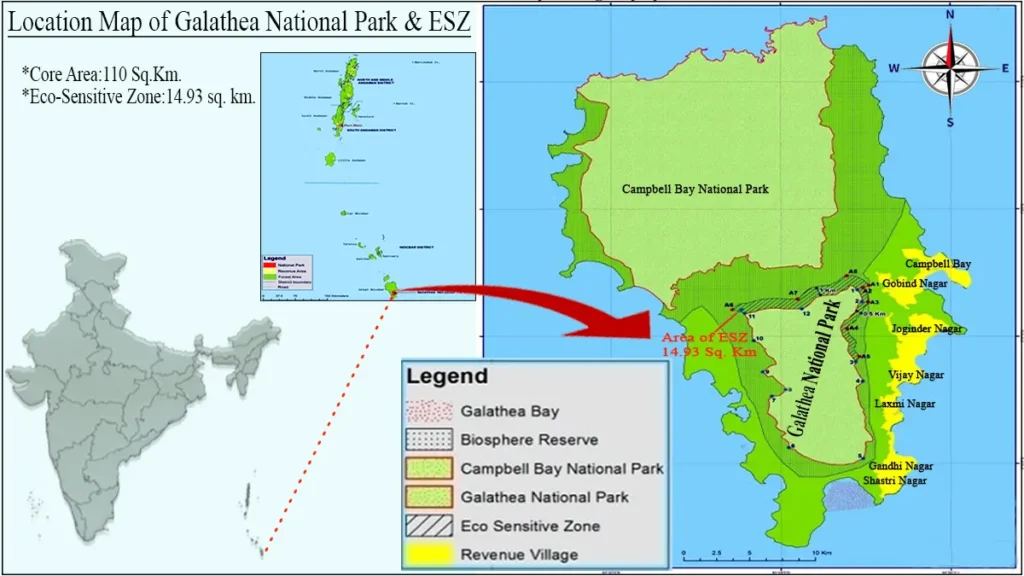
Biodiversity Highlights of Galathea National Park
The Galathea National Park receives a variety of species from the Indo-Chinese and Indo-Malayan regions. There are 648 plant species of 422 species, and 142 families, including 48 endemic and 85 rare or endangered species. There are 4 gymnosperm species and 77 pteridophytes, with tree ferns dominating the slopes of interior forests.
The park is home to 330 fauna species, including:
- 28 mammals (3 marine mammals)
- 97 birds
- 23 reptiles
- 10 amphibians
- 52 butterflies
- 24 odonates
- 20 spiders
- 76 aquatic Hemipterans
Galathea National Park is Famous For
Galathea National Park is famous for being a key nesting site for the Giant Leatherback Sea Turtle and for the conservation of species such as the dugong, Nicobar wild pig, Nicobar crab-eating macaque, Nicobar flying fox, Nicobar leaf-nosed bat, Nicobar Pigeon, Nicobar pipistrelle, garden lizard, estuarine crocodile, Andaman water monitor, and Nicobar tree shrew. It also has a lot of different plants and animals that are special to the area, including important coastal and mangrove ecosystems. Besides its biodiversity, the park holds significant value from various perspectives:
- Ecological: It plays an important role in maintaining ecosystem balance.
- Faunal and floral: It has special animals and plants that can’t be found anywhere else.
- Geomorphologic: The park has notable landforms and natural features.
- Recreational: It offers opportunities for tourism and nature exploration.
- Research/Educational: The area is important for scientific studies and educational purposes, contributing to environmental awareness and conservation research.
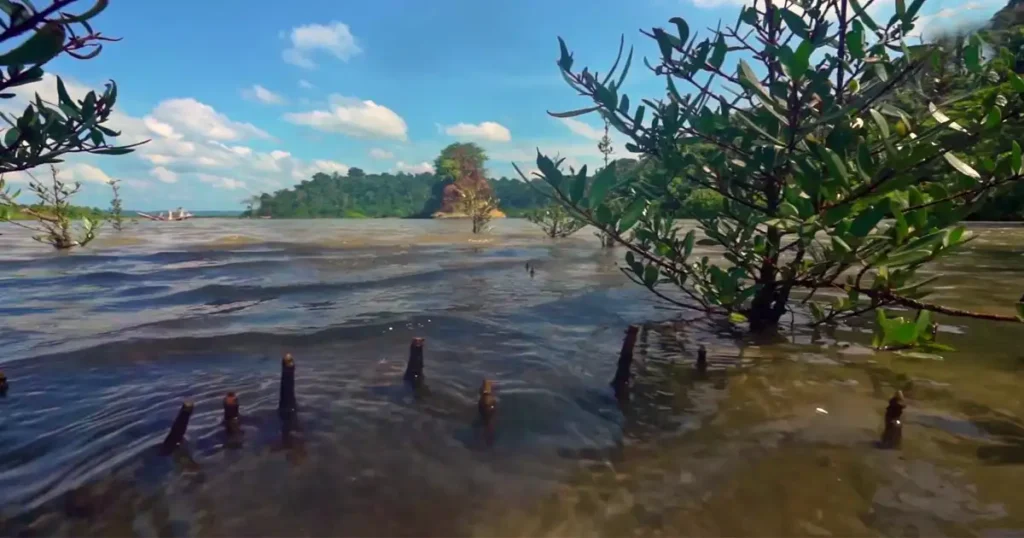
Galathea National Park Map
The map of Galathea National Park is marked by the MoEFCC in Notification S.O. 3874(E), issued on October 28, 2020, under the Environment (Protection) Act, 1986 which covers an area of 110 square kilometers, serving as a crucial habitat for diverse flora and fauna.
There is a designated eco-sensitive zone (ESZ) around the park’s boundary, which extends from 0 to 1 km outdoors and covers a total of 14.93 km2. This ESZ is notified to protect the ecological integrity of the park from developmental activities and to protect the biodiversity in and around Galathea National Park.
Boundary Description of Galathea National Park
1. North: Galathea National Park is part of the Great Nicobar Biosphere Reserve, including the larger Campbell Bay National Park, where the northern boundary is separated by a forest buffer zone of 12 km from Galathea.
- Starting at point 11 (6° 58′ N, 93° 47′ E), the boundary runs northwest to point A6 (6° 58′ N, 93° 46′ E), 1 km from the park boundary.
- It then moves east to point A1 (6° 59′ N, 93° 52′ E), maintaining a distance of 1 km from the park boundary, which passes through points A7 and A8.
2. East:
- It starts at Point 1 (6° 59′ 33.429″ N, 93° 52′ 8.570″ E).
- Then, it goes east to Point A2 (6° 59′ 40.690″ N, 93° 52′ 23.157″ E), which is 0.5 km from the park’s edge.
- Next, it goes south to Point A5 (6° 55′ 53.257″ N, 93° 52′ 13.565″ E) by passing through Points A3 (6° 58′ 52.401″ N, 93° 52′ 36.066″ E) and A4 (6° 57′ 24.953″ N, 93° 51′ 43.686″ E), keeping a 0.5 km distance.
- It then moves southwest to meet the park boundary at Point 3 (6° 55′ 36.340″ N, 93° 52′ 4.623″ E) and continues to Point 5 (6° 50′ 16.834″ N, 93° 52′ 22.608″ E).
3. South:
- From Point 5, it goes southwest to Point 6 (6° 50′ 52.594″ N, 93° 49′ 18.952″ E), following the park boundary.
4. West:
- From Point 6, it goes north to Point 11 (6° 58′ 15.837″ N, 93° 47′ 30.378″ E), passing through Points 7, 8, 9, and 10 while sticking to the park boundary.
The People of the Nicobar Islands and Galathea National Park.
The Nicobar Islands are home to different groups of people. One of them is the Shompen Tribe, a small group of about 229 people as per the 2011 census. The exact population of Shompen is still today unknown. They live in forest areas, especially near rivers and streams, including parts of the Galathea National Park. The Shompens are hunters and gatherers, depending on the forest and sea for food.
For the first time in history, 7 members of the Shompen tribe in the Andaman and Nicobar Islands cast their votes for the lone Lok Sabha seat in the union territory during the 2024 general election. They not only voted but also took selfies at polling station 411, known as ‘Shompen Hut.’
Another group is the Nicobarese Tribe. There are about 300 Nicobarese. They used to live along the west coast, but in 2004, a big tsunami destroyed their homes. After that, they moved to Afra Bay on the North Coast and Campbell Bay. The Nicobarese mostly survive by catching fish from the sea.
There are also settlers from the mainland, more than 8,000 people, living along the southeast coast. They farm, grow fruits, and fish for a living.
The Shompens move around between the Core Zone and Buffer Zone of the forest, including Galathea National Park, while the settlers and Nicobarese live in villages along the coast, which is part of the Transition Zone.

Geography of Galathea National Park
The geography of Galathea National Park is a major factor in the vegetation and biodiversity unique to the park. The protected area has a tropical humid climate due to its equatorial proximity, its insularity, and the geographic isolation of the islands. The influence of South-West and North-East monsoons has nurtured the growth of dense and varied vegetation cover.
Galathea National Park is famous for having one of the best-preserved rainforests in the world. Because of where it is located and its isolation, many plants and animals here are found only in this park. This amazing environment helps different plants and animals live and grow in the park’s special weather conditions.
The Galathea River, which flows through Galathea National Park, is the only perennial river in the area and is the longest at 40 km. At its source, it measures about 25 ft. wide and expands to 90 ft. wide near its mouth at the Indian Ocean, with a strong flow. The river is navigable for 30 km upstream from the mouth.
Originating in the adjacent Campbell Bay National Park on Mount Thullier, the tallest peak in the Nicobar Islands, this river flows southward through Galathea National Park. The river is 15 to 20 feet deep and its banks are covered with thick plants. The places where the river meets the sea are very important for turtles. They are great nesting spots for several types of turtles, like the Giant Leatherback, Olive Ridley, and Green Sea Turtles.
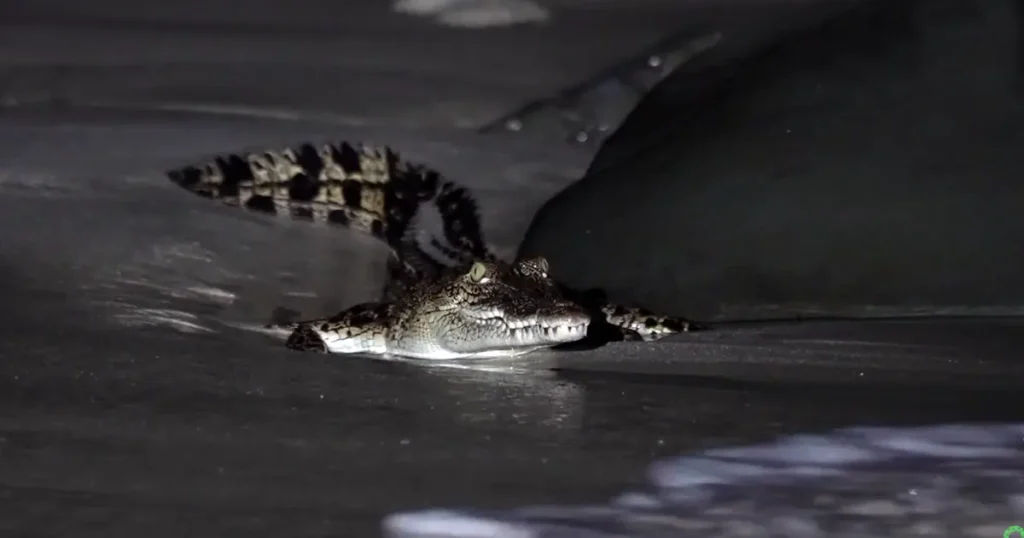
Climate of Galathea National Park
The climate of Galathea National Park is hot, humid, and tropical. It only has a summer season and a rainy season, so the people and animals here don’t experience winter like in other places.
During the rainy season, the park gets a lot of rain—about 3000 to 3800 mm each year. The climate is unique due to its tropical humid nature, being close to the equator, and the physical isolation of the islands. It also experiences both South-West and North-East monsoons, which contribute to the dense and diverse vegetation cover.
Because of its special location and surroundings, Galathea has some of the best-preserved tropical rainforests in the world, filled with many plants and animals that can’t be found anywhere else.
Plant Diversity in Galathea National Park
Galathea National Park is special because it has plants and animals from two regions: Indo-Chinese and Indo-Malayan. The park is home to about 648 species of plants from 422 genera and 142 families. Among these, 48 species are endemic (meaning they can only be found here) and 85 species are rare and endangered.
The park has 4 species of Gymnosperms from 3 genera and 3 families. The Pteridophytic group adds greatly to the park’s plant diversity, with 77 species, where tree ferns make up a significant portion of the vegetation.
Galathea National Park features many types of forests, including Tidal Swamp Forests (Mangrove Forest), Littoral Forest (Beach Forests), Low-Level Evergreen Forests (Coral Reef Forests), and Tropical Evergreen Forests (True Tropical Forests). Families like Euphorbiaceae, Rubiaceae, and Arecaceae have a high number of unique species found only in this area.
The mangrove forests are important because they help the environment in many ways. In total, 14 species of mangrove trees are recorded, including Rhizophora apiculata, Bruguiera gymnorrhiza, and Sonneratia caseolaris. The park also has climbing plants and orchids, like Derris trifoliata and Dendrobium crumenatum. Some economically valuable plants, like Nypa fruticans and Vanilla anadamanica, also grow here.
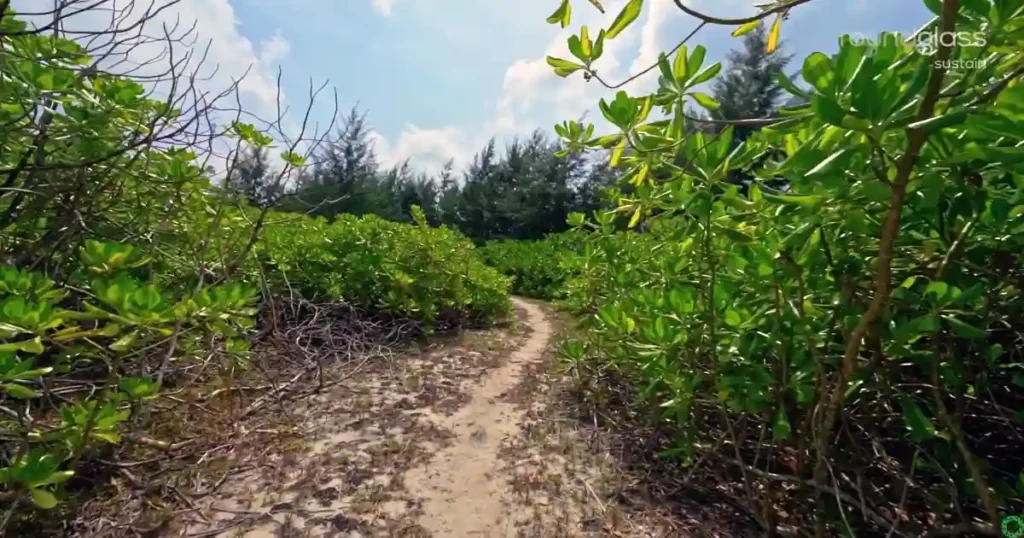
Wildlife of Galathea Bay National Park
Galathea National Park is home to a total of 330 animal species. This includes 28 mammals (3 of which are marine mammals), 97 birds, 23 reptiles, 10 amphibians, 52 butterflies, 24 dragonflies, 20 spiders, and 76 types of aquatic bugs. The park has some amazing and rare wildlife, including the Nicobar Crab-eating Macaque, Nicobar Wild Pig, Dugong, Nicobar Tree Shrew, Nicobar Flying Fox, and several types of rats.
Some special birds found here are the Nicobar Tiger Bittern, the Nicobar Cuckoo Dove, and the Nicobar Emerald Dove, among others. The park is home to the Nicobar Pigeon and different kinds of kingfishers.
The Galathea River flows through the park, providing perfect nesting spots for the Giant Leatherback Sea Turtle, Olive Ridley Turtle, and Green Sea Turtle.
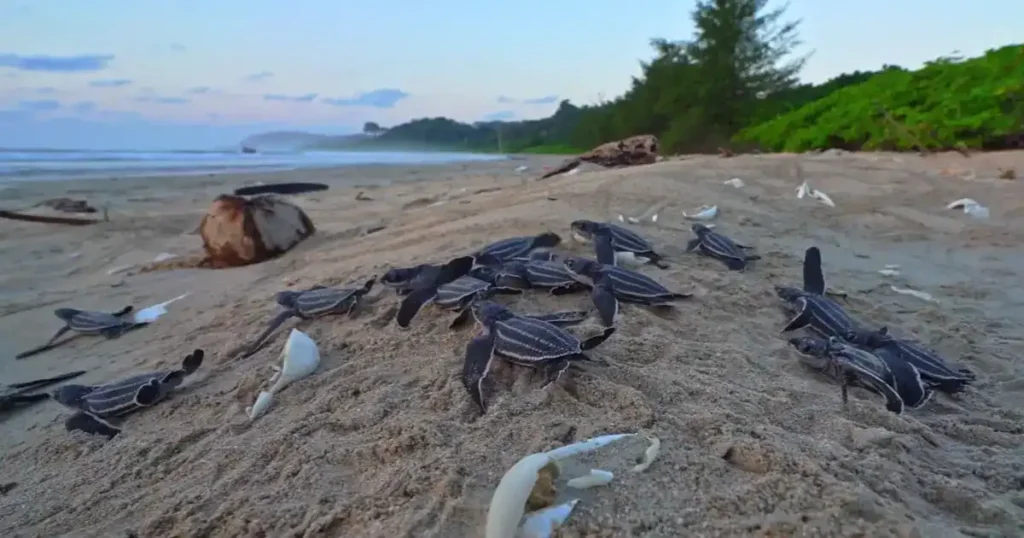
What to See at Galathea National Park, Andaman & Nicobar
Galathea National Park is a repository of wildlife and unique landscapes. It is home to rare animals that are nowhere to be found, such as the Nicobar megapod, the Nicobar pigeon, the Andaman wild boar and the Andaman hill myna. The park also has saltwater crocodiles, monitor lizards, and many kinds of snakes. For ocean lovers, the park’s vibrant coral reefs are filled with colorful fish, sea turtles, and even dolphins.
There are lots of exciting activities here, from snorkeling and scuba diving to nature walks. Prices for these safaris depend on how long and what kind you choose. Guided tours are also available for an extra fee. Birdwatching is a big hit, and if art and adventure are more your thing, the park offers sea walking, boating, and even art exhibitions.
Amazing Animals in the Park:
- Leatherback Turtle: It is the world’s largest turtle, swimming 45–65 km a day. They nest at South Bay from December to February..
- Crab-Eating Macaque: This kind of monkey lives in tropical rainforests, spends most of its time up in the trees, and even eats crabs.
- The Saltwater crocodile: It is the biggest among all species of crocodiles which is usually found in saltwater environments like mangrove swamps and river mouths.
Other Animals You Might See:
- Mammals: Try spotting the Andaman Wild Pig, Palm Civet, and Fruit Bats.
- Birds: One may be lucky to spot Nicobar Pigeon, White-Bellied Sea Eagle and Nicobar Serpent Eagle along with some colorful parakeets.
- Reptiles: Here, you can spy on the the water monitor lizard and the reticulated python.
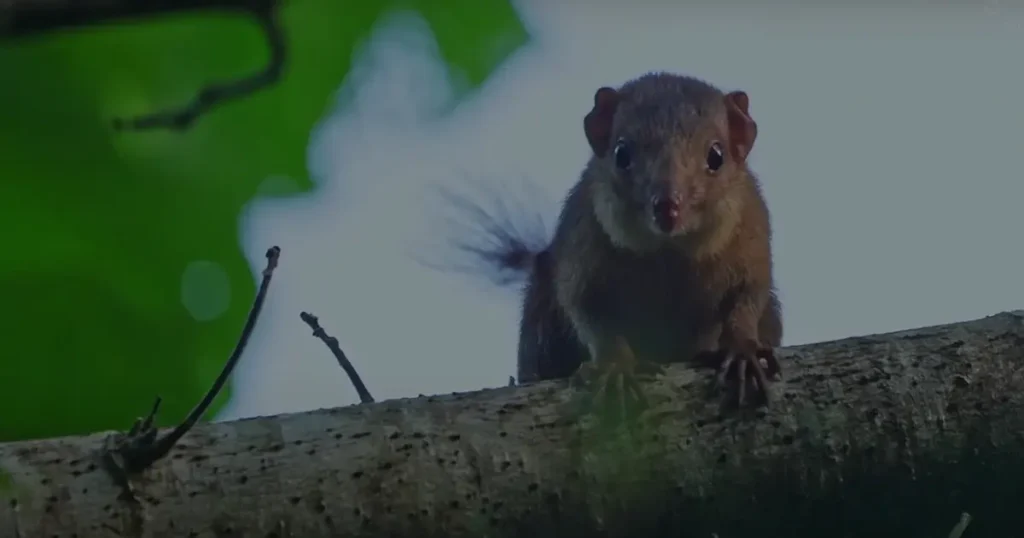
How to Get to Galathea National Park
- By Air: The nearest airport is Port Blair, which is about 540 kilometers from Galathea National Park. Flights to Port Blair are available from major cities like Delhi, Kolkata, and Chennai.
- By Sea: Regular ships sail to Port Blair from Visakhapatnam (around 1,200 km), Kolkata (about 1,300 km), and Chennai (approximately 1,200 km). After arriving at Port Blair, ferry services will take you to Galathea National Park, which is about 540 kilometers away. The park is also reachable from Indonesia, and the network connection is weak and unstable.
Where to Stay
There are plenty of hotels and rest houses available for your stay. You can book them online through the official Andaman tourism website.
Important for Foreign Visitors:
All foreign nationals need a Restricted Area Permit (RAP) to visit the Andaman & Nicobar Islands. Make sure to get this permit before starting your trip.
When to Visit Galathea National Park
Galathea National Park is open all year round, but the best time to go is from December to March. During these months, the weather is pleasant and comfortable which is perfect for exploring the park and seeing all the amazing sights.
The climate here is hot, humid, and tropical. There are only two seasons: summer and rainy season. This means that both people and animals in the park don’t get to enjoy winter like in other places. So, if you love warm weather, Galathea is a great place to visit.
Conclusion
The Great Nicobar Island is not only one of the most strategically important areas in the Andaman and Nicobar Islands region of India but is also special because of its protected plants and animals. Galathea National Park on this island is the best-preserved tropical rainforest in the world and shows a high degree of indigenousness due to its physical isolation and geographic location. The park is surrounded by the ocean, isolated from the mainland, creatures have taken independent routes to evolution, evolving into species that exist nowhere else in the world.
Whether you love nature, enjoy adventures, or want to relax in a beautiful setting, Galathea National Park is the perfect place to connect with the great outdoors.
FAQ
Q: What is Galathea National Park famous for?
A: Galathea National Park is famous for an important nesting site for the Giant Leatherback Sea Turtle. It helps protect many special animals like the dugong, Nicobar wild pig, Nicobar Pigeon, and estuarine crocodile.
The park is also home to unique plants and animals, especially in its coastal and mangrove areas and the best-preserved tropical rainforests in the world, filled with plants and animals found nowhere else.
Q: Which River flows through Galathea National Park?
A: The Galathea River is the only perennial river that flows through Galathea National Park, and is the longest at 40 km. It is Originating in the adjacent Campbell Bay National Park on Mount Thullier, the tallest peak in the Nicobar Islands.
Q: How do I go to Galathea National Park?
A: To reach Galathea National Park, first travel to Port Blair. Flights from cities like Chennai or Kolkata take about 2 hours. From Port Blair, a ferry ride of around 50 to 60 hours leads to the park.
Q: What are the two national parks in the Great Nicobar?
A: The two national parks in Great Nicobar are Galathea National Park and Campbell Bay National Park, both designated as part of the Great Nicobar Biosphere Reserve.
Q: The relevance of Galathea National Park in UPSC examinations.
Galathea National Park is located in the Nicobar District of the Andaman & Nicobar Islands. It was declared a National Park in 1992 covering 110 square kilometers and a part of Great Nicobar Biosphere Reserve status granted on January 13, 1989. In 2013, UNESCO declared this region a World Heritage Site.
You May Also Like

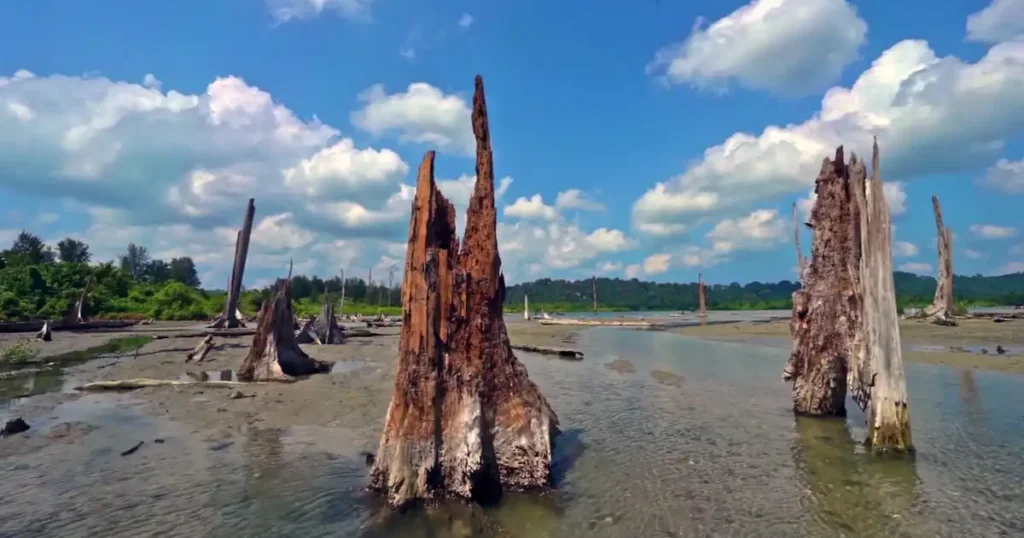


2 thoughts on “Galathea National Park”